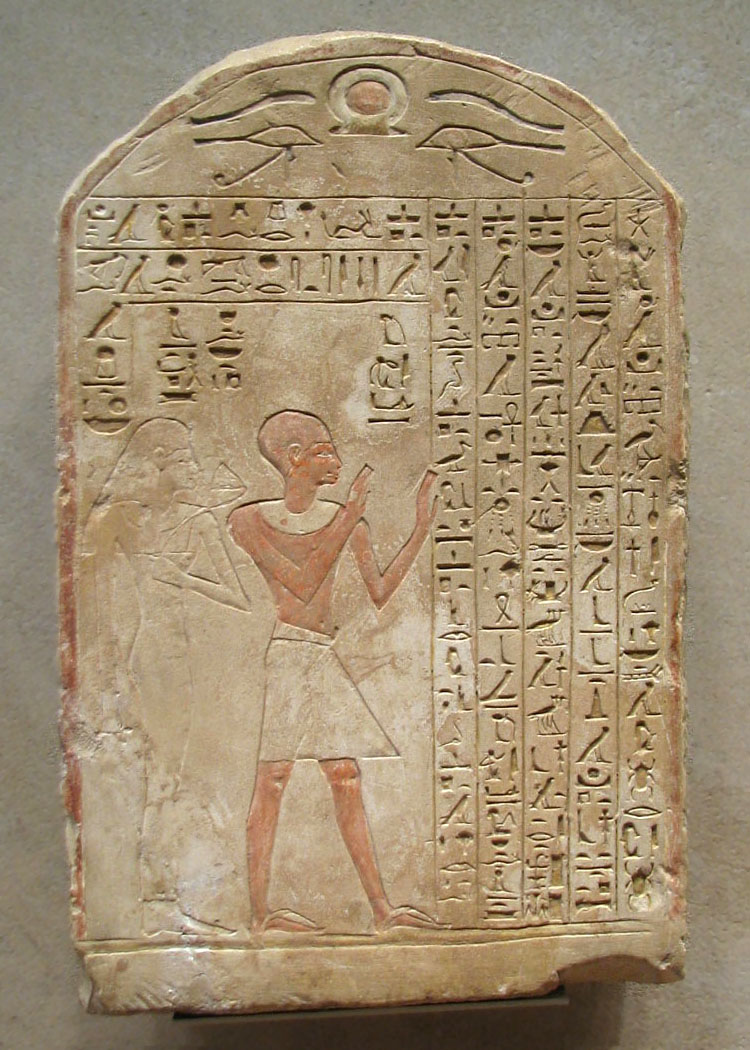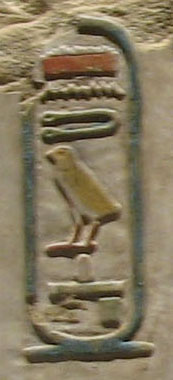
New Kingdom, Dynasty 18, Reign of Thutmose I–Amenhotep II, ca. 1427–1400 B.C.E.
Upper Egypt; Thebes
Limestone, paint, H. 42.5 cm (16 3/4 in); w. 27.5 cm (10 13/16 in)
Rogers Fund, 1912, MMA 12.182.2
full size underneath for hieroglyph examination.
 New Kingdom, Dynasty 18, Reign of Thutmose I–Amenhotep II, ca. 1427–1400 B.C.E. Upper Egypt; Thebes Limestone, paint, H. 42.5 cm (16 3/4 in); w. 27.5 cm (10 13/16 in) Rogers Fund, 1912, MMA 12.182.2 full size underneath for hieroglyph examination. |
|
I first saw this stela in 2005 at the Metropolitan Museum. My eagle eyes saw the Set hieroglyph and found a translation was presented, which I copied down in a notebook:
The standing figures are identified as priest Amaini, and his wife, the house mistress Inet-Hopi. (The translation is made possible by Anne and David Mininberg MMA - 1995)
Thoth is understood to be the one that healed both Set and Horus after their contendings, enabling them both to be 'content'.
Re-Harakhti's enemy is the Apep snake, whom Set slays daily to keep him safe as he travels the solar barque. Set is regarded as the only one strong enough to get the job done.
So let's focus on the phrase regarding Set:
|

|
I was fascinated and got out Budge's two volume set of hieroglyphs to identify each word. Of course, the Set determinative is obvious:
 Enlarged and clarified from TeVelde's "Seth, God of Confusion"
 Mentuhotep

|

| I looked for the word 'with': |


'He, his, its'
| But then I looked up 'to have', and found this: |

|
Perhaps the ancient logic is the scrotum holds the testicles. (There is still the hieroglyph in the upper left
which I didn't find, which could be a variant for 'testicles'.) In addition to the original translation, the nuance may
be "May Set possess his power." or "May Set be content, possessing the source of his power." Or more likely, Amaini is addressing each God directly, as he begins that way, 'Hail, Atum...'. "Be content, Set, possessing the source of your power!" or less delicately phrased, "Be content, Set, powerful, possessing your balls." I was just thinking, this page could end up in some odd search strands, maybe I better explain why the ancients were concerned with the health of a deity's nads. It is all due to 'the contendings of Set and Horus'. They struggle, and in the process, with all the nasty hits, they do injury to each other. Horus hits 'below the belt', and Set goes for the eye. Thoth must come in and reconcile them, and mend their injured bits. (You will note in the Amaini stela, "May Horus be content with his Eye", to ensure all are happy.) This tale is also metaphor for Set being the power of the pharoah, and Horus being the vision of the pharoah. In the quest for Sovereignty (with or without 'crown'), these aspects must be balanced, between rulership in the inner world and rulership in the outer world.
|


